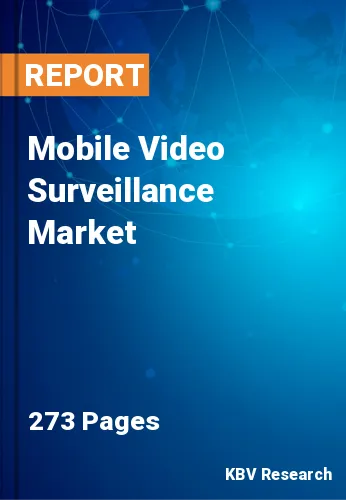The Global Mobile Video Surveillance Market size is expected to reach $3.8 billion by 2028, rising at a market growth of 8.2% CAGR during the forecast period.
The popularity of mobile video surveillance, which allows video to be wirelessly streamed using a mobile video surveillance camera to a control center, is on the rise. Users with various business locations need remote and real-time access to the surveillance data, thereby enabling the remote monitoring of the site.
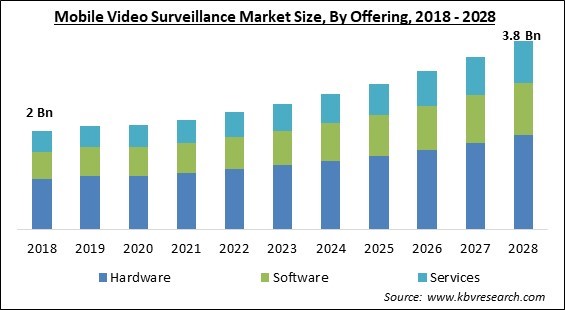
To offer adequate security from theft, vandalism, fraud, and terrorism, transportation authorities, governments, and businesses are constantly searching for more adaptable and practical video surveillance technology. The idea behind mobile video surveillance is to enable real-time monitoring of a live video feed utilizing smartphones and tablets.
Mobile device access to video surveillance feeds significantly contributes to improving public safety and security by providing prompt intervention in the event of any unpleasant situations. With smartphones, tablets, or laptops linked to an internet network, accessing the live video feed is simple. As a result, mobile video surveillance is a more practical option than traditional video surveillance systems.
The installation of video surveillance equipment on mass transit vehicles has grown during the past few years. Mobile video surveillance is becoming commonly used in public transportation with the goal of enhancing user security and safety. Depending on the type of vehicle, mobile video surveillance employs a combination of inside and outside cameras.
The operation of interior cameras involves keeping an eye on passengers and staff, giving crucial information to fight off crime and liability concerns from clients and staff. The purpose of external cameras is to make it easier to monitor a vehicle's functioning and provide video evidence in the event of an accident. Most mobile video surveillance systems can record high-definition (HD) video at a frame rate between 20 and 30 frames per second.
The COVID-19 markets have a significant impact on the market for mobile video surveillance systems, much like other sectors do. The lockdown and epidemic impacted and constrained the market for mobile surveillance video. There was a smaller market for sales due to several variables. As a result, the industry takes action to modernize its processes and increase sales among the target market. The COVID-19 pandemic affected technological advancement, which in turn, reduced consumer demand. The supply chain is interrupted as a result. The COVID-19 effect also has an impact on the financial aspect of the market and industry for mobile video surveillance.
With the widespread usage of smartphones and tablets, which have more computing power, the utilization of the internet and related devices has substantially expanded during the past several years. Smart gadgets are now being used by end users to access surveillance data and remotely monitor places. Popularity also rising for mobile video surveillance, which allows video to be wirelessly streamed from a mobile video surveillance camera to a control room. Users with various business locations need remote and real-time access to the surveillance data in order to monitor the site remotely.
Systems for mobile video monitoring that are intelligent are now crucial for maintaining safety and security as well as spotting trends and patterns. Software for intelligent mobile video surveillance systems makes use of artificial intelligence. These apps, particularly for mobile transportation applications, assist in the analysis of the audio and video captured by the video cameras to identify people, animals, objects, and events.
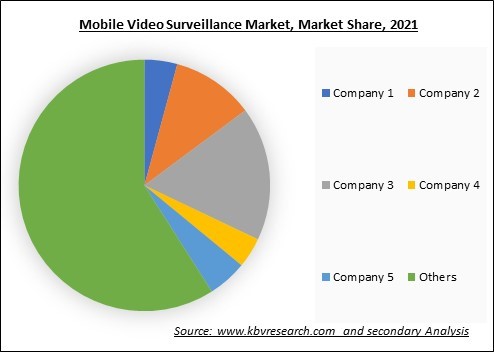
The leading players in the market are competing with diverse innovative offerings to remain competitive in the market. The below illustration shows the percentage of revenue shared by some of the leading companies in the market. The leading players of the market are adopting various strategies in order to cater demand coming from the different industries. The key developmental strategies in the market are Product Launch.
When several manufacturers are involved, the need for interoperability standards frequently prevents cameras and related devices from functioning together. Systems for managing video control frequently employ expensive proprietary software interfaces across several platforms. Organizations like law enforcement, the government, or other budget-constrained bodies that lack the resources for developing proprietary software and are also compelled to use several suppliers by rules governing public funding do not benefit from this.
Based on offering, the market is segmented into Hardware, Software, and Services. The hardware segment had the highest revenue share in 2021. Cameras, video encoders, and storage options are some of the hardware elements utilized in mobile video surveillance systems. These provide enough high-quality images in a range of monitoring settings, including challenging circumstances in the transportation industry. Mobile video closed-circuit television, which is outfitted with smart video management software and analytics, aids in addressing several new security and safety issues.
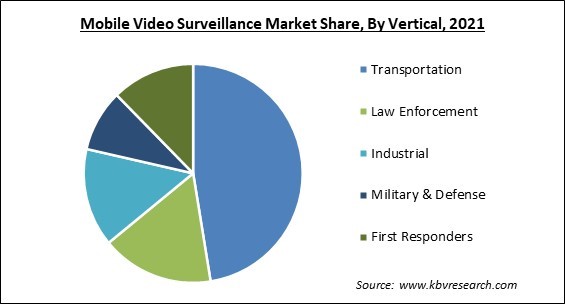
Based on application, the market is bifurcated into Railways, Buses, Police Vehicles, and Transport Vehicles & Drones. During the projected period, the mobile video surveillance market for Transport Vehicles & Drone applications is anticipated to develop at a high CAGR. Drones are frequently deployed and easily integrated with command, control, computers, communications, surveillance, intelligence, and reconnaissance systems. They feature straightforward operations and upkeep processes and strong tactical skills.
Based on the verticals, the market is categorized into Law Enforcement, Industrial, Military & Defense, First Responders, and Transportation. The transportation sector acquired the highest revenue share in 2021. The demand for mobile video surveillance has grown in the transportation sector due to an uptick in criminal activity, liability claims, and threats from vandalism and terrorism. In the transportation industry, mobile video surveillance systems are employed to deter criminal activity, catch criminals, and offer passengers a safe and secure environment.
| Report Attribute | Details |
|---|---|
| Market size value in 2021 | USD 2.2 Billion |
| Market size forecast in 2028 | USD 3.8 Billion |
| Base Year | 2021 |
| Historical Period | 2018 to 2020 |
| Forecast Period | 2022 to 2028 |
| Revenue Growth Rate | CAGR of 8.2% from 2022 to 2028 |
| Number of Pages | 274 |
| Number of Tables | 480 |
| Report coverage | Market Trends, Revenue Estimation and Forecast, Segmentation Analysis, Regional and Country Breakdown, Competitive Landscape, Market Share Analysis, Companies Strategic Developments, Company Profiling |
| Segments covered | Offering, Application, Vertical, Region |
| Country scope | US, Canada, Mexico, Germany, UK, France, Russia, Spain, Italy, China, Japan, India, South Korea, Singapore, Malaysia, Brazil, Argentina, UAE, Saudi Arabia, South Africa, Nigeria |
| Growth Drivers |
|
| Restraints |
|
Based on geography, the market is divided into North America, Europe, Asia Pacific, and LAMEA. North America led the Mobile Video Surveillance Market in 2021 and registered the major revenue share in the global market. The region would continue its dominance in the market globally. The need for sophisticated surveillance cameras is anticipated to rise in North America, which includes the US, Canada, and Mexico, for military and defense purposes. The growing deployment of surveillance equipment in the US is driving the industry.
Free Valuable Insights: Global Mobile Video Surveillance Market size to reach USD 3.8 Billion by 2028
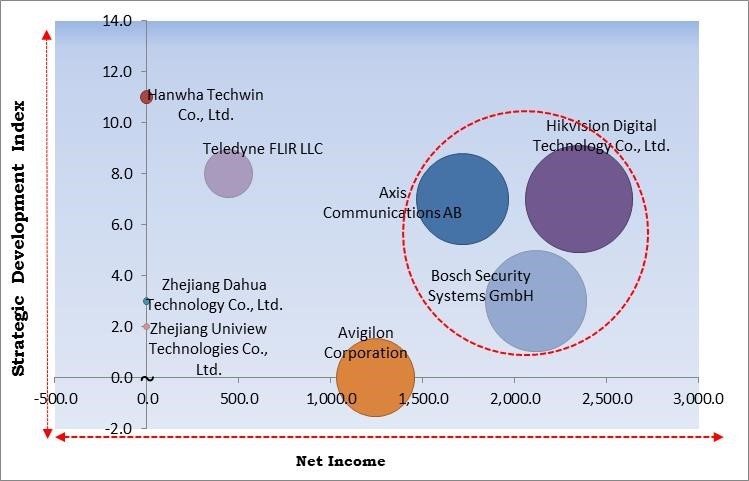
The major strategies followed by the market participants are Product Launches. Based on the Analysis presented in the Cardinal matrix; Bosch Security Systems GmbH (Robert Bosch GmbH), Hikvision Digital Technology Co., Ltd. (China Electronics Technology Group Corporation), Axis Communications AB (Canon, Inc.) are the forerunners in the Mobile Video Surveillance Market. Companies such as Avigilon Corporation (Motorola Solutions), Hanwha Techwin Co., Ltd., Teledyne FLIR LLC (Teledyne Technologies Incorporated) are some of the key innovators in Mobile Video Surveillance Market.
The market research report covers the analysis of key stake holders of the market. Key companies profiled in the report include Hikvision Digital Technology Co., Ltd., Zhejiang Dahua Technology Co., Ltd., Axis Communications AB (Canon, Inc.), Hanwha Techwin Co., Ltd., Bosch Security Systems GmbH (Robert Bosch GmbH), Avigilon Corporation (Motorola Solutions), Teledyne FLIR LLC (Teledyne Technologies Incorporated), and Zhejiang Uniview Technologies Co., Ltd.
By Offering
By Application
By Vertical
By Geography
The global Mobile Video Surveillance Market size is expected to reach $3.8 billion by 2028.
A Rise In The Adoption Of Wireless Smart Devices are driving the market in coming years, however, Different manufacturers' mobile cameras have different compatibility requirements restraints the growth of the market.
Hikvision Digital Technology Co., Ltd., Zhejiang Dahua Technology Co., Ltd., Axis Communications AB (Canon, Inc.), Hanwha Techwin Co., Ltd., Bosch Security Systems GmbH (Robert Bosch GmbH), Avigilon Corporation (Motorola Solutions), Teledyne FLIR LLC (Teledyne Technologies Incorporated), and Zhejiang Uniview Technologies Co., Ltd.
The Buses segment acquired maximum revenue share in the Global Mobile Video Surveillance Market by Application in 2021 thereby, achieving a market value of $1.6 billion by 2028.
The North America market dominated the Global Mobile Video Surveillance Market by Region in 2021, and would continue to be a dominant market till 2028; thereby, achieving a market value of $1.3 billion by 2028.
Our team of dedicated experts can provide you with attractive expansion opportunities for your business.
